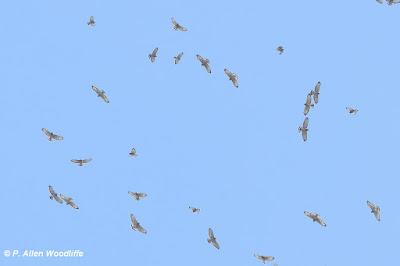Migrating raptors have been on the move a lot recently. The two hawk watches in extreme SW Ontario and SE Michigan have documented thousands of raptors, especially Broad-winged Hawks, but sometimes ten different species over the course of a day. Mid to late September is definitely the peak time for the Broad-wings. However seeing them, and photographing them, certainly have their own challenges.
Many raptors, especially the broad wing types, also known as Buteos which is the genus of their scientific name, use the uplift of air thermals from the effects of bright sunshine on the ground, to carry them upward, When the effect of the uplift falls off, the raptors then stream off in the direction they intend to migrate to catch the next thermal uplift to form the next kettle of soaring hawks. It really is quite amazing, but means that weather is a significant factor influencing their migration. On sunny, warmish days with winds from a generally northerly direction, the migration along the lake shoreline can be quite spectacular. They seldom fly over the lake, as there are no thermals created by the sun reflecting off the water, so they follow the shoreline and leave Ontario, via crossing the Detroit River, to continue on their southward migration all the way to Central or South America.
The challenge can be, in a bright blue sky, and if the hawks happen to be at the top of their kettle, they can be impossible to see without good optics. So to help to find a kettle, a hawk watcher will explore some of the white clouds while using binoculars as a dark raptor stands out better. But that makes it challenging for photography, as a dark hawk against a bright white cloud, is not the kind of lighting photographers like.
I have been out on several occasions trying to see and photograph migrating raptors. Success has been variable, but on one recent occasion, things worked out fairly well. It was on a morning when there was lots of blue sky of late summer, and only a few white clouds. At first I was not seeing much of anything, but when I started to explore the sky through my binoculars, I could see hawks on the move. This first photo shows a distant group of Broad-winged Hawks, flying almost directly overhead, but without binoculars, I couldn't see them at all. I managed to find them in my telephoto lens, and this first shot is taken at about the equivalent of a 22X binocular. The birds are not all that big, are they (the large on on the lower right is a Turkey Vulture, while the rest are all Broad-wings).
One kettle of Broad-wings I estimated to be around 400 birds,and there were several smaller kettles. In less than a couple of hours, I concluded there were at least 800 Broad-wings which had gone over. According to the hawk watch sites a little farther to the west, there were probably 10,000 or more of this species pass by over the course of that same day.
There were other broad-winged types of hawks go by, especially a few Red-tailed Hawks.
Other species went through as well, albeit in much smaller numbers. The accipiters and falcons generally did not soar quite as high, and were fairly quick to show up and flew directly southwest, so it was hard to get the camera and focus on them very successfully. A few American Kestrels came by....
....as did some Sharp-shinned Hawks.
Northern Harriers came by in very small numbers, and I didn't get any photos of them. They were usually too far to attempt. Turkey Vultures, were steadily in sight but not always very close by.
All in all, it was quite a successful time, and I am sure there were many hawks that I missed since I was on my own, and putting most of my effort into photographing them. At the hawk watch locations mentioned earlier, there are usually several watchers whose main purpose is to record everything in sight, and some days the records are in the tens of thousands overall.
On other occasions I went to places like the Erieau Marsh Trail. There wasn't a lot to photograph or even see during the time I was there, but I did get a few photos. Small groups of Wood Ducks are here and there. They are normally skittish when people are around, but I got these photos through some small gaps in the shrubbery surrounding the ponded area they were feeding in.
An adult Bald Eagle flew quickly overhead, and this shows what photographing a black and white bird against a white cloud can end up looking like even after a lot of processing.
A quick stop at the local sewage lagoons turned up a few species of shorebirds including a somewhat uncommon White-rumped Sandpiper, but I only got photos of the much more common Lesser Yellowlegs....
...and Pectoral Sandpiper.If you would like to subscribe, or unsubscribe, to Nature Nuggets, send an email to: prairietramper@gmail.com


















Love the raptors using the uplift of air thermals. It reminds me of growing up in Kenya and watching them circling, which would ultimately lead us to a lions kill, while they waited their turn in the 'pecking' order.
ReplyDeleteThanks, Paula. Quite a different reason for circling, but for the necessary reasons.
DeleteImpressive photos!
ReplyDeleteDo you still go down to Hawk Cliff in Elgin Co?
Thanks! I haven't been to Hawk Cliff for many years. By the time the hawks get this far west, there are usually more to look for as they funnel to the Detroit River to cross to their next leg of their journey, and it is a lot closer to home.
Delete